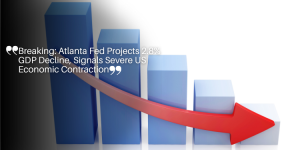The Reality of Persistent Inflation: What Economic Experts Want You to Know
October 2023 showed a notable 2.6% increase in consumer prices compared to the previous year.
This uptick follows a period of relative stabilization observed from 2022 to 2023 but marks a rise from the inflation rate reported in September.
Economists emphasize that while the situation represents a step down from the peak inflation challenges faced in 2022, the inflation crisis is far from over.
Persistent Economic Concerns
Despite the overall improvement, the lingering inflation highlights ongoing economic concerns.
Many expected that the easing of inflationary pressures seen earlier in 2023 would lead to a more sustained reduction in prices.
However, October’s data serves as a reminder that inflation remains a persistent issue.
The Federal Reserve has been continually adjusting its policies to counteract rising prices, demonstrating the complexities and challenges of managing the current economic climate.
Contributing Factors and Challenges
Several factors contribute to the persistent inflation.
Supply chain disruptions, labor market dynamics, and geopolitical uncertainties all play a role in keeping prices elevated.
For instance, some industries continue to struggle with obtaining necessary components, which drives up costs.
Additionally, wage increases in certain sectors, aimed at retaining talent in a tight labor market, are also contributing to the upward pressure on prices.
Consumer Impact
The increase in consumer prices affects households differently depending on their income levels and spending patterns.
Essential goods and services, like food and housing, often see the most significant price hikes, disproportionately impacting lower and middle-income families.
This scenario complicates budgeting for many households, forcing them to make tough choices about their expenditures.
Continued vigilance and strategic financial planning are essential for navigating this challenging economic landscape.
The current inflationary trends underscore the need for adaptive and creative financial solutions to help mitigate the impact on consumers’ day-to-day lives.
As we explore further, it becomes clear how rising costs influence various sectors of the economy, including the housing market.
Impact on Housing Market
Prohibitively Expensive Housing Costs
The housing market is experiencing significant challenges due to persistent inflation.
Major metropolitan areas are particularly hard-hit, making homeownership a distant dream for many.
The exorbitant cost of living in these regions, compounded by rising housing prices, has left potential buyers struggling to afford even modest properties.
This reality is evident in cities like San Francisco and New York, where sky-high prices continue to soar, pushing many aspiring homeowners out of the market.
Structural Defects in High-Priced Homes
A stark example of the current housing dilemma can be seen in the Bay Area.
Properties in this region, even those priced in the $800,000 range, often come with structural defects.
For instance, Joe Christiano and his sister faced numerous hurdles as they searched for a home in this price bracket, only to encounter properties with significant issues.
Such experiences highlight the dire state of the housing market, where high costs don’t necessarily equate to high-quality homes.
Innovative Solutions: House Hacking
Amid these challenges, new and innovative solutions are emerging.
One such strategy gaining popularity is “house hacking.”
This approach involves renting out portions of a property to offset mortgage payments, making homeownership more achievable for those priced out of the traditional market.
By think outside the box and adapting to current economic conditions, more individuals are finding paths to secure housing.
Additionally, startups like Nestment are stepping in to assist buyers who are struggling to enter the market.
These companies offer innovative financial solutions and support, making it possible for more people to realize their homeownership dreams despite the economic hurdles.
The rise of such startups and creative housing strategies marks a shift in how people approach the challenges of an expensive housing market.
Adaptive Financial Solutions
Innovative Startups Changing the Game
As home prices soar, innovative financial solutions are emerging to help prospective buyers enter the daunting housing market.
One notable startup, Nestment, is making waves by offering alternative pathways to homeownership.
Targeting those priced out of traditional markets, Nestment enables small groups to pool their resources and invest in properties collectively.
This model not only lowers the financial barrier to entry but also fosters community-driven living arrangements, which can be particularly appealing in costly urban areas such as the Bay Area.
Alternative Housing Arrangements
When traditional methods fail, alternative housing arrangements are becoming more common and necessary.
House hacking is one such strategy gaining traction among savvy buyers.
Essentially, house hacking involves purchasing a property and then renting out part of it, such as a basement apartment or additional rooms, to cover mortgage costs.
This trend is a practical response to housing affordability issues, allowing homeowners to generate income while securing a place to live.
Beyond house hacking, other creative solutions include co-housing arrangements and tiny homes.
Co-housing communities provide a blend of private living spaces and shared common areas, fostering a sense of community while significantly reducing living costs.
Tiny homes, though not a one-size-fits-all solution, offer a minimalist and cost-effective way for individuals to own property without the financial burden of a larger home.
Financial Strategies for Economic Challenges
Facing economic challenges head-on requires innovative financial strategies.
Beyond startups like Nestment, other creative financial solutions have become critical tools for those navigating the current economy.
These include:
- Utilizing government and local grants designed to aid first-time homebuyers
- Exploring lease-to-own options, which help renters gradually transition to homeownership
- Leveraging financial technology apps that offer savings plans, investment advice, and mortgage calculators to better manage finances
These tools and strategies emphasize the importance of adaptability and resourcefulness in tackling today’s financial hurdles.
They demonstrate that despite the daunting nature of the housing market, there are viable paths to securing homeownership.
Economic shifts continue impacting all generations, and the financial landscape is ever-evolving.
As we delve deeper into the economic implications across generations, it’s essential to remember that adaptability and innovative thinking can pave the way forward.
Generational Economic Implications
Gap Between Inheritance Expectations and Reality
For many young adults, the expectation of receiving a substantial inheritance from their parents could be shaping their financial planning and future aspirations.
However, recent studies paint a starkly different reality.
According to a report from Northwestern Mutual, only about one-fifth of the baby boomer generation anticipate leaving an inheritance.
This significant gap between expectation and reality suggests that many could be in for a rude awakening.
The reasons behind this gap are manifold.
Rising costs of living, healthcare expenses, and a desire to enjoy their retirement years means many boomers are spending more of their savings than previous generations.
For millennials and Gen Z, this means relying solely on savings and personal investments to build their financial future.
Shift in Traditional Wealth Transfer Patterns
The traditional model of wealth transfer from parents to children is undergoing a transformation.
It’s no longer the norm for retirees to leave a sizeable inheritance, signaling a shift in how wealth is distributed across generations.
Several factors contribute to this shift:
- Increased Life Expectancy: People are living longer, increasing the period during which they need their savings.
- Economic Volatility: Markets fluctuate, affecting retirement savings and investments.
- Healthcare Costs: Medical expenses continue to rise, consuming a more significant portion of retirees’ nest eggs.
This changing pattern means younger generations will need to adopt new financial strategies. Instead of expecting a financial windfall, they should focus on concrete steps like early retirement planning, diversifying income sources, and investing wisely.
As we move forward, addressing these intergenerational challenges will be crucial.
Young adults and financial advisers will need to work together to navigate this new landscape, ensuring financial stability and security for the future.
This examination of inheritance expectations and wealth transfer highlights the broader economic strategies that younger generations need to adopt.
Moving forward, it’s essential to keep an eye on the broader economic trends and adaptive solutions in response to these changing dynamics.







